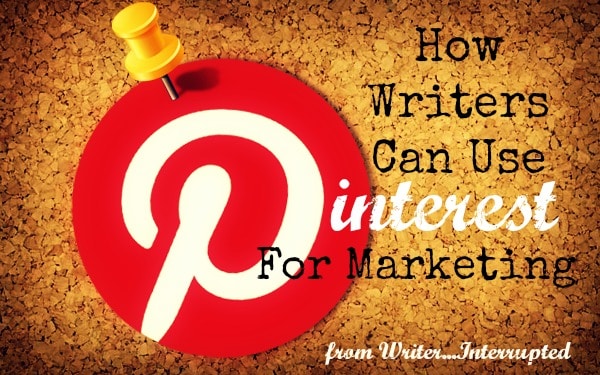How Writers Can Use Pinterest for Marketing

Last month Brandy gave us a great piece on why writers should NOT use Pinterest. Anyone who has visited the site can tell you how quickly a few minutes turn into hours browsing pins. And while it can be a catalyst for creativity, it can also quickly deplete your confidence and cause overload paralysis. In her article, she offered four great reasons why writers should stay away from it. (Click here to read her entire piece.)
Today, however, I offer you a few reasons why would SHOULD use Pinterest and some tips on how to do it well.
Why should writers be on Pinterest?
- It is one of the fastest growing social networks. Don’t believe me? Check out these stats from Social Media Today and Tech Crunch. In less than two years it grew from its initial beta form to the third largest social network, standing only behind Twitter and Facebook. Anything that grows that fast is a powerful marketing source, one that writers would do well to employ.
- It engages users … I mean READERS. Pinterest offers another platform, a very visual one, through which we can reach and engage readers. Some authors, like Liz Curtis Higgs, create entire boards about their characters. What would they wear? How would they do their hair? What architecture might be in the scenery? Whether it’s before the book is published or after, this helps readers visualize the totality of your story. It adds another sense to the show-don’t-tell element of communication. Also, it gets them excited! It starts conversations.
- It spurs visual creativity and imagination. While these boards engage readers, they also serve writers as tools of research and inspiration. K. M. Weiland, for example, has boards for each of her books, her characters, their settings, modes of transportation and even their costumes. Similar to how some writers clip magazines for their office walls and storyboards, Pinterest allows for virtual clipping and pinning. Same purpose, new method.
- It increases traffic. Aside from Google and Facebook, I get more referrals to my website from Pinterest than from all other sources combined. That includes a number of my active networks, such as YouTube, Twitter, NetworkedBlogs and Google+. Simply put: it works.
How can writers use Pinterest with marketing purpose?
That all sounds great, but it’s no secret how one can easily get lost, wasting hours of valuable writing time, in the vortex of Pinterest. Let’s be honest — that can happen on any website, social media or otherwise. The key to using any social network with purpose lies in effective boundaries and tactics.
Here are some suggestions:
- Track your time. If you have no reason to be there, don’t be there. I keep track of how much time I spend on Pinterest. I don’t use an actual timer, but I want to be sure that my time spent there is purposeful. If I’m just browsing, not really looking for anything in particular, I’m wasting time and I need to get off.
- Distinguish between pins and likes. There are a million cute things on Pinterest, but I only pin things I will actually reference. I may “like” other things, but if it’s not something I’ll actually use or something that helps my readers in some way, then I don’t pin it. Not only does this prevent additional time wasting, it also keeps me focused and my boards clutter-free. The last thing I want to do is overwhelm myself or my readers.
- Verify pins. Before pinning anything, make sure they link to accurate articles and posts and that (to the best of your knowledge) follow copyright guidelines. If the link is invalid or the content questionable, steer clear. You want your readers to trust you. Links that go nowhere deplete your credibility.
- Create niche boards. This plays into the anti-clutter rule, but it also helps establish your brand and expertise. I have boards that appeal to other writers — Marketing and Social Media, A Writer’s Life (which is about craft, business and writing encouragement), and Office Spaces (ways to organize and decorate working at home) — but most of my boards appeal to my target audience. Encourage : Incite features inspirational quotes and challenges; Big Word Bible Studies offers links to all of my study guides, references and vlogs; Mission-Minded Family and Intentional Parenting feature articles and tools that equip readers to apply the truths of God in their homes and communities. These are areas I address specifically with my writing, so they directly appeal to my target audience. This also provides a ready avenue for readers to find my books when released. Of course, I have other boards for personal reasons — recipes, gardening, crafty stuff — but I don’t spend a lot of my time there.
- Contribute to group boards. Surely you’re not the only one writing for your audience. Find like-minded writers and pool your resources. For example, I am part of a board for Devotions and Bible Studies. It has over 10,000 followers, only a handful of whom follow me directly. Participating on this board allows me to reach pinners far beyond my personal scope of connections with relevant content from my own website.
- Make your website Pin-friendly. Can your readers share you on Pinterest? Create an account and let them know you have it. Invite them to share you with friends. Make your images easy to pin. There are a number of ready widgets and plug-ins that will do this for you.
Talk to me. Why do or don’t you use Pinterest? Feel free to link to your boards in the comments! I’d love to check them out.